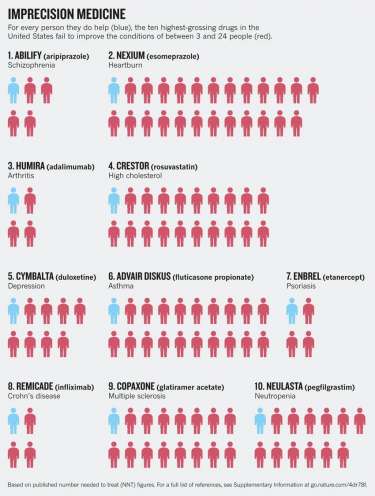
#mobile #eye #trends
21. Apr. 2020 |
- min Lesezeit
Let’s start with a few rather shocking numbers. Did you know that 40% of diagnoses are misdiagnoses? That means out of 5 visits to the doctor 2 of them will result in a wrong diagnosis and the wrong treatment. Another aspect of this story is the ineffectiveness of our drugs.
A popular concept to measure this is the “number needed to treat” short NNT. It explains how many people you have to give a drug until you see a responder. So if you have a drug with a NNT of 2, it means that, if you give this drug to 2 patients, only one of them will be helped by the drug. A glance at the top 10 drugs of the US looks horrifying. Take for example Crestor, a medicine against high cholesterol, whose NNT is 20. If you would be suffering from high cholesterol and your doctor would prescribe you this drug, there would be only a 5% chance that it would help you.

With those alarming numbers on the one side, on the other side a growing and aging population in the western world will only make the demand for high quality healthcare services more urgent. To summarize, the current system needs to be improved! This is where AI and Big Data come into play. By leveraging the capabilities of emerging technologies, healthcare will be able to transform itself in a way, which the manufacturing industry is currently undergoing (industry 4.0). We at DPM identified 3 big trends which emerge from this transformation:
Preventive healthcare aims to utilize data to detect and prevent disease. This can mean to detect symptoms at an early stage, which can often help to at least limit the severeness of the disease run, but also to support the patient in his/her treatment or to live a healthier lifestyle. Besides the benefits for the patients, the healthcare industry can avoid costs. Today, we can see the first appearances of this trend already: wearables warn you about potential heart diseases, nano-robots promise to constantly monitor your blood sugar and countless applications provide support their users, to eat better, exercise more or help them to deal with stress.
Have you ever tried to diagnose yourself by using online resources? It seems to us, no matter the symptoms, you will almost surely find out that you definitely have a deadly disease. Despite this current state of affairs, imagine you could actually use the internet to provide a virtual hospital to everyone. Such a virtual hospital could serve as a central place where data is collected and analyzed. Artificial intelligence would screen the incoming data, establish connections and unveil hidden information. A set of interconnected sensors would transmit a patient’s personal and medical information in real time and the AI would help the doctor with diagnoses, treatments and warnings. This way, the doctor does not need to be physically co-located with the patient anymore. This has massive implications on scaling, it would be possible to provide healthcare for all of those people who nowadays don’t have access to a doctor or specialized equipment such as heavy, expensive ct-machines.
In classical medicine, we try to develop and prescribe drugs that show effects on as many people as possible. While this one-fits-all-strategy definitely had benefits for our society and saved many lives in the past, it ignores all the individual factors that are associated with a patient. In the words of Clayton Christense: we need to shift from our intuition based medicine to a precision medicine. Artificial intelligence can help to design new drugs that are tailored to a very specific target group and help to pick a drug that has the highest likelihood to work for you (remember the NNT) personally at a much lower cost. You as a patient could communicate with the AI, decide which data to use and on which suggestions to act.
We notice more and more applications of Big Data and AI in healthcare every year. However, few of them belong to companies from the Healthcare sector. Surprisingly, it is the tech giants, such as Apple or Samsung, who are driving the innovation. We at DPM draw the following conclusion from this:
On the one hand, this development should be alarming for pharma companies. If they don’t innovate, they will risk being pushed back to a simple supplier role, while the new leaders of the healthcare sector would be tech companies with their innovative products and business models. It is therefore necessary for pharma companies to develop their data & analytical capabilities and cooperate with digital companies in order to remain a driving force in the market.
